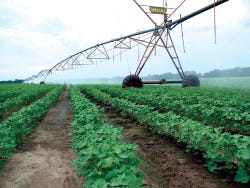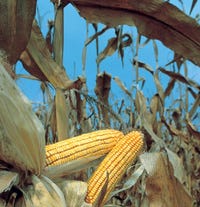
While land prices in the Mid-South haven’t attained the stratospheric levels of those in Iowa and California, they have nonetheless seen good appreciation, says George Baird, owner/operator of Baird & Brunson Land Management Group LLC, Collierville, Tenn. “In the past 12 months, farmland prices in our region have continued to climb,” he says, “with increases being reported between 6 percent to 15 percent.
May 2, 2011

As commodity prices have reached levels farmers could once only dream of, farmland prices have also soared as investors look for ways to get a better return on their money and to hedge against inflation (which the Federal Reserve continues to insist is negligible).
Consider recent media and financial institution reports:
• 80 acres of rich farmland in Iowa sold last month for $10,000 an acre. Just two years ago, similar land fetched $6,000 an acre. Another Iowa farm, 118 acres, recently brought $11,000 an acre. — New York Times.
• An acre of farmland in Fresno County, Calif., has risen about 20 percent over the past year, from $11,000 to nearly $13,000. — Fresno Bee.
• Midwest farmland prices rose 12 percent in the fourth quarter of 2010, according to the Chicago Federal Reserve Bank. The Kansas City Federal Reserve Bank reported cropland prices up nearly 20 percent over previous year levels.
In a recent Federal Deposit Insurance Corporation forum, “Don’t Bet the Farm — Assessing the Boom in U.S. Farmland Prices,” FDIC Chairman Sheila Bair noted, “Farmland values have doubled on average in the past 10 years and continue to rise in an environment of ample liquidity and low interest rates.
“While we see strong fundamentals in the farm sector at present, the sector remains vulnerable to a reversal of market conditions or a rise in interest rates,” she said. “The lending and borrowing decisions made now, when collateral values are high, will shape credit performance down the road.”
Earlier, Thomas Hoenig, president of the Federal Reserve Bank of Kansas City, said in a Senate Agriculture Committee hearing that he had “a nagging concern” that the big runup in farmland prices could be an unsustainable bubble that could burst and damage the nation’s economy.
“It is nearly impossible to determine how much of the farmland boom may be an unsustainable bubble driven by financial markets, and how much results from fundamental changes in supply and demand conditions,” he said.
 While land prices in the Mid-South haven’t attained the stratospheric levels of those in Iowa and California, they have nonetheless seen good appreciation, says George Baird, owner/operator of Baird & Brunson Land Management Group LLC, Collierville, Tenn.
While land prices in the Mid-South haven’t attained the stratospheric levels of those in Iowa and California, they have nonetheless seen good appreciation, says George Baird, owner/operator of Baird & Brunson Land Management Group LLC, Collierville, Tenn.
“In the past 12 months, farmland prices in our region have continued to climb,” he says, “with increases being reported between 6 percent to 15 percent. Even higher values have been reported in some areas where the market was slow to catch on over the last few years.
“In many parts of the Delta, we are seeing quality irrigated land selling from $3,200 to $3,800 per crop acre, with reports of land sales regularly topping $4,000 per acre and pushing toward $5,000 in some instances.
“I would suspect that as commodity prices continue to hold and demand remains strong, these trends will continue, but moderate somewhat.”
Baird, who grew up on a cotton farm in Sunflower County, Miss., says while there is a great deal of interest from outside investors in the Delta farmland market, most of the purchases are being made by local farmers and local landowners.
Diversity offers unlimited possibilities
“The diversity of the land throughout the Delta gives unlimited possibilities. Integration of land development and irrigation and adoption of the latest technologies, ranging from equipment to new varieties, ultimately allow us to increase efficiency, maximize yields and increase returns. This is being recognized by people on both a local level and national level as they realize we have the capability to compete agriculturally with any region of the U.S. and the world.
“Outside investors are looking to our area as a way to diversify their portfolios and take advantage of recent trends. Compared to an area like the Midwest, it is much easier to put together sizable tracts of land, whether to continue to cash lease them out or to introduce some type of custom operation into the mix.
“When you look at the production capabilities of our land and its cropping flexibility,” Baird says, “then consider how production agriculture has evolved in the Mid-South in the last 10 years and where the next 10 years might take us, I still contend Delta farmland is relatively undervalued in today’s market compared to other regions of the country.
 “That’s not to say it’s a cakewalk here — production risks will always exist — but the opportunities often outweigh those risks when a long perspective is taken.”
“That’s not to say it’s a cakewalk here — production risks will always exist — but the opportunities often outweigh those risks when a long perspective is taken.”
While the Fed chairman, the president, and others maintain the recession is over, Baird says, “Many others worry that we could see a relapse in the economy, and they are looking to farmland as a hedge against current uncertainty and future inflation.
“If we look back at total return over the last 45-plus years, farmland as an investment has outpaced inflation and the S & P index. Adding to the bullish sentiment for agriculture is a growing world population, increases in per capita protein consumption, and dwindling supplies of commodities as a result of production problems in the last several years due to drought, floods, earthquakes — all at a time when demand is increasing.”
Despite an ever-increasing level of uncertainty and volatility, opportunities for increased profitability are also bringing newcomers into agriculture, Baird says.
Yield and production capability
“The way to manage these uncertainties and take advantage of the potential in agriculture in today’s markets involves a number of factors, but the No. 1 emphasis is yield and production capability. The Mississippi River Delta is blessed with rich soils, a good growing climate, and ample groundwater. In fact one of the biggest problems we have in many areas is getting rid of excess water.”
In today’s volatile climate, “farming in not simply about planting and harvesting, but includes developing a complete risk management program that encompasses production, input costs, technology, weather, USDA policies, and marketing decisions.
“Investors, landowners, and operators must take a look at how all of these aspects work together and look forward with a five-year, 10-year, or even longer-term vision to develop a complete farm management plan and seek properties that either are highly developed or have opportunity to incorporate improvements that will help minimize risk and maximize production.
 “I believe the market is beginning to recognize the variances in the quality of farmland and improvements and that this will begin to be priced accordingly. If additional work is needed, those capital expenditures must be taken into consideration.
“I believe the market is beginning to recognize the variances in the quality of farmland and improvements and that this will begin to be priced accordingly. If additional work is needed, those capital expenditures must be taken into consideration.
“New technologies, varieties, equipment and tillage practices can open up new opportunities for crop rotations and mixes that might not previously been considered possible.
As land prices continue to push higher and commodity prices continue to move upward, landowners, operators, and investors will continue seeking to take advantage of the bullish markets, Baird says.
“But, I would prefer to see the hoopla currently surrounding commodity prices and land values, and the negative press we often get in the mainstream media, subside. When every day another story on network television is playing up increases in food prices and how much money is being made, it is often with a negative spin.”
Volatility and economic uncertainty are “today’s reality and the world we live in,” Baird says. “If we in agriculture don’t educate the general public and tell the story of the American farm and the benefits we bring to local communities, states, and the health and ultimately security of our nation, who will?
“There are tremendous challenges before us, but the opportunities can also be great. Those of us in the agricultural community need to tell our story to the public and explain benefits from American agriculture at home and abroad.”
You May Also Like



